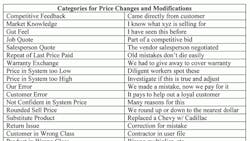Polygraphs, Pricing and Process
The polygraph machine stands at the ready. A white-coated technician sits coolly at the controls. A single white light illuminates the small room. Business leaders line up outside the door, each ready to enter and submit to a forensic study of their blood pressure, pulse, breathing rhythms and skin conductivity. One by one, devices are strapped and connected. Each person undergoes a single question interrogation.
“Does your organization have a pricing strategy?”
One by one they, nod their heads in the affirmative. And one by one, they pass the lie detector test. With this scenario in place, let’s start off with a premise – every organization on the planet has a pricing strategy. The real question should have been:
“Who in your organization has the power to override your strategy?”
Can any one of a dozen people tap a few keys and short-circuit your pricing strategy? It scares the heck out of me to consider that a new guy sitting at the counter can change the strategy. In essence, they can extend any price to any customer.
You may not have planned it that way; maybe you started with a password for overriding price levels. But somewhere along the line, override approval became a rubber stamp. And subsequently, you shared the password. Before you knew it, it was easy to change prices.
Let’s look in on a scene happening thousands of times a day on the front lines of our business. Joe the electrician visits the counter of a HVAC-R wholesaler. It seems that Joe occasionally does a tiny bit of heating and cooling work and knows where to get his supplies. He selects a couple of sensors and some thermostat wire and looks at the new tools. Now the moment of truth, your counter sales person prices the order. Joe is a contractor and a pretty good guy to boot. They know the price that Giant Heating and Cooling pays. The cash counter price seems pretty high. So why not give Joe the contractor price? With a couple of key strokes, your pricing strategy bites the dust.
If you believe this has happened any time in the past month, stop reading this and make a note: “Talk to IT about resetting the price override password.” But that isn’t enough. You need to change your company’s policy. Let employees know that changing prices without authorization is a hanging offense.
Now a word of caution: Salespeople, customer service guys and counter folks will push back. They will grouse about losing orders and the need for fast-moving reactions to competitive threats. And they are right – sometimes pricing needs adjustment. But I suggest you limit pricing authority to one or two people. Make sure this very select group understands how serious pricing strategy is in our industry. Further, this hand- picked team needs to be privy to your strategy and evaluated on the strategy’s success.
Measure the overrides
After shutting off the floodgates of authorization, I recommend creating a file (paper or electronic) to track the reasons for price overrides. Review of this file will provide a great tool for “tuning up” the existing price files. One distributor we talked to uses a system with 18 separate classifications for the override. Here’s his list:
The results found in these files are the rudimentary start to turning a pricing strategy into an actionable process. Some of these issues are easy to explain. Sometimes we stock out of a common item and need to sell its more expensive big brother for a lower price to cover our inventory issue. Other times, we do have an honest-to-goodness competitive issue on our hands. This information allows you to better understand the market and drive for higher margins.
The end of data-free decisions
Back in the dark ages, before interactive business systems and the computing power they bring, pricing strategy was an art form. A business owner had a gut feeling for the success or decline of their strategy. Mistakes were common, but the business environment was a whole lot more forgiving.
Today, technology is available to everyone. As I write these last few words, it dawns on me. I have more computing power sitting on my lap here in the airport than most third-world countries just a dozen or so years ago.
Technology allows for easy gathering and analyzing of data. For instance, organizations like Strategic Pricing Associates of Cleveland have developed algorithms for scientific analysis of past customer invoices. These provide a unique view of the relationship between customer types and price sensitivity. Armed with data, we can easily evaluate how successful our pricing strategy is. The coolest part is that David Bauders, SPA’s president, has gone on record saying they can drive results in just a few weeks.
If you have a pricing strategy but no pricing process, give us a call. We can help direct you to the right help.
Frank Hurtte is the founding partner of River Heights Consulting, a consulting firm specializing in “knowledge-based” distribution. He is the author of the NAW Publication The Distributor Specialist: Customer Champion, Profit Generator! Hurtte’s work centers on four basic questions: Does a sales process drive profit, which processes create greatest bottom line impact, why do target-driven sales organizations enjoy a 47 percent advantage, and what have upper quartile distributors discovered about specialist deployment? Discover the answers at [email protected]
